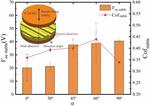Friction ( IF 6.3 ) Pub Date : 2024-05-07 , DOI: 10.1007/s40544-024-0861-z Weixu Yang , Jieyang Wang , Xiaoli Wang , Ping Chen

|
Sliding-mode triboelectric nanogenerator (S-TENG) is based on the coupling of triboelectrification and electrostatic induction, converting electrical energy from sliding motion. Introducing micro-textures into the sliding surface, and adjusting the angle between the texture and sliding direction (direction angle) may achieve performance anisotropy, which provides novel ideas for optimizing the tribology and electrification performance of S-TENG. To guide the performance optimization based on the anisotropy, in this paper, groove micro-textures were fabricated on the surface of S-TENG, and anisotropic tribology and electrification performance were obtained through changing the direction angle. Based on the surface analysis and after-cleaning tests, the mechanism of the anisotropy was explained. It is shown that the anisotropy of friction coefficient can be attributed to the changes of texture edge induced resistance and groove captured wear debris, while the voltage anisotropy is due to the variations of debris accumulated on the sliding interface and the resulting charge neutralization. Among the selected 0°–90° direction angles, S-TENG at angle of 90° exhibits relatively small stable friction coefficient and high open-circuit voltage, and thus it is recommended for the performance optimization. The open-circuit voltage is not directly associated with the friction coefficient, but closely related to the wear debris accumulated on the sliding interface. This study presents a simple and convenient method to optimize the performance of S-TENG, and help understand the correlation between its tribology and electrical performance.
中文翻译:

具有凹槽纹理的滑模摩擦纳米发电机的各向异性摩擦学和起电特性
滑模摩擦纳米发电机(S-TENG)基于摩擦起电和静电感应的耦合,将滑动运动转换成电能。在滑动表面引入微观纹理,并调整纹理与滑动方向之间的角度(方向角)可以实现性能各向异性,这为优化S-TENG的摩擦学和带电性能提供了新的思路。为了指导基于各向异性的性能优化,本文在S-TENG表面制作凹槽微纹理,通过改变方向角获得各向异性摩擦学和带电性能。基于表面分析和清洗后测试,解释了各向异性的机理。结果表明,摩擦系数的各向异性可归因于织构边缘诱导电阻的变化和凹槽捕获的磨屑的变化,而电压各向异性则归因于滑动界面上积累的磨屑的变化以及由此产生的电荷中和。在选取的0°~90°方向角中,90°方向角的S-TENG表现出较小的稳定摩擦系数和较高的开路电压,因此推荐用于性能优化。开路电压与摩擦系数没有直接关系,而是与滑动界面上积累的磨屑密切相关。本研究提出了一种简单方便的方法来优化 S-TENG 的性能,并有助于理解其摩擦学和电气性能之间的相关性。






























 京公网安备 11010802027423号
京公网安备 11010802027423号